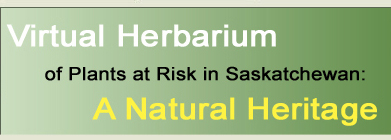
|

|

|

|

|

|

|
|
|
|
|
|
| Parnassia palustris var. parviflora (DC.) Boivin | Species Image Gallery (opens in a new window) |
||||||||||||||||||||||||||
| TAXONOMY | |||||||||||||||||||||||||||
| Family: | Saxifragaceae | ||||||||||||||||||||||||||
| Genus: | Parnassia | ||||||||||||||||||||||||||
| Species Synonyms: | Parnassia parviflora DC. | ||||||||||||||||||||||||||
| Common Names: | smallflower grass-of-parnassus | ||||||||||||||||||||||||||
| DISTRIBUTION | |||||||||||||||||||||||||||
| Canada: | northern British Columbia – western Alberta, southeastern Saskatchewan, Ontario – Quebec – Labrador – Newfoundland – Nova Scotia | ||||||||||||||||||||||||||
| Saskatchewan: | southeastern Saskatchewan; Strawberry Lakes – Qu’Appelle River Valley | ||||||||||||||||||||||||||
| Ecoregion: | Aspen Parkland | ||||||||||||||||||||||||||
| HABITAT | |||||||||||||||||||||||||||
| Saskatchewan: | wet areas | ||||||||||||||||||||||||||
| Canada: | bogs and wet meadows | ||||||||||||||||||||||||||
| RARITY STATUS | |||||||||||||||||||||||||||
| Provincial
Status According to Harms (2003): |
Threatened |
||||||||||||||||||||||||||
| Nature Conservancy Status: | G4T4 ST1 |
||||||||||||||||||||||||||
| Saskatchewan
Species at Risk Status: |
None |
||||||||||||||||||||||||||
| COSEWIC Status: | None |
||||||||||||||||||||||||||
| Parnassia palustris var. parviflora is threatened because it is extremely rare and is only known from two locations in Saskatchewan. Possible threats have been identified for this species. | |||||||||||||||||||||||||||
| SPECIES DESCRIPTION | |||||||||||||||||||||||||||
| Height: | 5 – 30 cm | ||||||||||||||||||||||||||
| Roots: | fibrous | ||||||||||||||||||||||||||
| Stems: | scapose, slender | ||||||||||||||||||||||||||
| Leaves: | basal, 1 – 2 cm long, 7 – 20 mm wide, oval, tapering to a petiole; cauline leaf inserted at or below the middle, sessile, 7 – 15 mm long, narrow | ||||||||||||||||||||||||||
| Inflorescence: | flowers solitary, terminal | ||||||||||||||||||||||||||
| Flowers: | calyx lobes 3 – 6 mm long, ascending in flower and fruit, lanceolate; petals 5 – 9 mm long, slightly longer than the sepals, elliptical to oblong, 5 – 7-nerved; staminodia 5 – 7 on each scale; stamens 4 – 7 mm long, surpassing the staminodia | ||||||||||||||||||||||||||
| Fruits: | capsule ovoid | ||||||||||||||||||||||||||
| |||||||||||||||||||||||||||